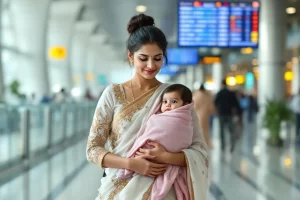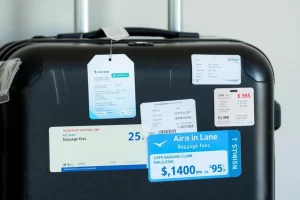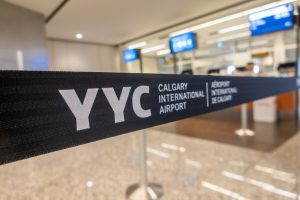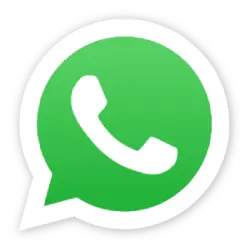Inshorts
Pre-book mobility and medical assistance at least 48 hours before your flight for a smooth experience.
Wheelchair assistance and support for mobility aids are free for passengers with medical needs or limited mobility on Canada to India flights.
Medical oxygen can be arranged with proper paperwork and airline approval to ensure a sufficient amount is available during air travel.
Electric wheelchairs require advance notice and battery details.
Families and seniors get priority boarding and connection assistance.
Cabin crew assist with movement but not medication or feeding.
Carry all relevant medical documents, including fit-to-fly certificates, in your carry-on baggage.
Consult your physician about your fitness to travel and discuss all relevant medical conditions before your trip.
Inform the airline and airport authorities in advance if you need special assistance like a stretcher.
Know how to handle flight disruptions to keep your travel plans smooth.
Use effective jet lag hacks for long flights to help manage fatigue and adjust to new time zones more comfortably.
Mobility & Medical Assistance on Canada–India Flights
Traveling long distances with mobility or medical needs requires advance notice. Accessible travel options are available for passengers with disabilities or special needs, ensuring a comfortable and barrier-free experience. Airlines between Canada and India offer wheelchair assistance and accessibility services if informed 48 hours ahead. Cabin crew are trained in first aid to support passengers. Seniors and families should plan accordingly and consult travel agents for help with accessible travel arrangements, especially for those with medical conditions. It is important to consider differences in time zones when coordinating assistance and connecting flights.
How to Book Wheelchair Assistance Canada to India
Booking special assistance with airlines for wheelchair support on Canada to India flights is straightforward if you follow these steps:
Book your flight early and mention you need wheelchair assistance.
You can add wheelchair requests when making reservations or by calling customer service.
Make your request at least 48 hours before travelling to avoid last-minute issues.
Wheelchair assistance is always free for those with medical needs, disabilities, or limited mobility.
Airlines may charge able-bodied passengers or those booking for convenience, based on recent guidelines and applicable charges.
Travelers can typically make requests for special assistance Canada India flights online during the booking process or afterwards via the “Manage Your Booking” section on the airline’s website.
Wheelchair support is offered from check-in, through security, boarding, and up to your seat inside the aircraft cabin. For arrivals, wheelchairs are ready at the gate or in the arrivals hall. Passengers requiring assistance are often offered priority boarding to allow extra time to settle into their seats. Passengers with medical needs must not be seated near emergency exits due to safety regulations. Seniors booking Canada to India flights can benefit greatly from these services when searching for flight deals to India.
Airline Medical Oxygen Booking Process
If you need medical oxygen on international flights, follow these key steps:
Inform the airline at booking or as early as possible, at least 72 hours before the scheduled departure time.
Complete the Medical Information Form (MEDIF) signed by your doctor; approval may take up to five working days.
Specify the required oxygen flow rate and ensure a sufficient amount of oxygen bottles or oxygen cylinders are available for the entire flight duration. Oxygen cylinders may be provided or approved by the airline, subject to airline regulations.
Bring your doctor’s prescription and medical documents; some forms may need to be submitted via e-mail to the airline for review.
Use battery-powered medical devices when possible, as medical power outlets may not be available.
Only battery-operated nebulisers are allowed in flight, except during take-off and landing.
Portable oxygen concentrators (POCs) must be FAA/EASA-approved; check device compatibility with the airline.
Oxygen supplies on board must be pre-approved. The crew cannot provide oxygen unless your paperwork is complete. Passengers with certain medical needs may require medical clearance before travel. Passengers requiring in-flight oxygen request should do so well in advance, specifying the flow rate needed for medical reasons.
Changes in cabin pressure during flight can affect oxygen levels, and supplementary oxygen may be necessary for passengers with respiratory conditions.
There may be an additional cost for arranging in-flight oxygen or special medical services, and all arrangements are subject to safety reasons and airline approval. Approval for medical oxygen and related services is determined on a case by case basis, depending on the passenger’s health status and documentation. Passengers should also be aware of regulations in certain countries and any applicable charges that may arise.
Airline Rules for Oxygen Concentrators
When traveling with portable oxygen concentrators on Canada to India flights, airlines have specific rules to ensure safety and compliance:
Only approved portable oxygen concentrator poc and portable oxygen concentrator models are permitted. POCs must be FAA/EASA-approved and meet internationally accepted criteria.
Rules for portable oxygen concentrators and medical devices may differ on domestic flights, so passengers should check with the airline for specific requirements.
Passengers must bring their own medical equipment and ensure it has an ‘aircraft-type approved’ certificate.
Battery-powered devices are preferred as medical power outlets may not be available on all aircraft. Passengers should check if their medical devices are compatible with aircraft power and seat power outlets, and bring an adequate power supply to last the entire flight duration.
Passengers should carry a letter from their doctor explaining the need to bring medical equipment.
Additional restrictions apply to lithium batteries used in some concentrators.
Airlines may require advance notice and medical clearance Canada India flights before approving the use of POCs onboard.
Other medical devices, such as continuous positive airway pressure machines, may also be allowed if they meet airline requirements.
Travelling with Your Own Wheelchair and Medical Equipment
Many passengers prefer using their own wheelchairs or medical equipment, whether manual or battery-powered. Other mobility aids are also supported for air travel. Here’s what you need to know:
Inform the airline of your wheelchair’s make, model, and battery type at least 48 hours before your flight. Electric wheelchairs must meet airline safety rules, with battery details required for approval.
You may bring your own medical equipment if it meets internationally accepted criteria and is airline-approved. Proper safe disposal of medical waste like syringes is important.
Wheelchairs, mobility aids, and medical equipment travel free and will be stored safely in the cabin or cargo hold per airline rules, ensuring compliance with dangerous goods regulations.
Pack medication according to airline guidelines; refrigerated meds can be transported in a cool bag or vacuum flask with permitted dry ice.
Service dogs must be leashed or harnessed at all times, and passengers must provide documentation of training and health checks. Regulations vary by country and other countries’ local authorities.
Passengers with certain medical conditions or severe illness may need to provide additional documentation or undergo assessment for medical clearance before traveling.
A medical escort, who is a qualified medical staff member, may be required for critically ill passengers or those with complex medical conditions; air ambulance services are an option for complex medical needs.
Official travel documents and detailed information should be accessible for passengers with disabilities, and information should be available in an accessible format for passengers with disabilities.
Assistance for Families and Seniors
For Indian families, students, and seniors:
Priority boarding is given to those with mobility devices.
Help is available for connecting flights, navigating busy airports, and finding seating.
Cabin crew can guide you to and from seats but cannot administer medication or personal care.
Cabin crew can assist with stowing carry-on baggage, moving around the cabin, and using the onboard wheelchair, but cannot assist with personal care functions or administer medication.
Service dogs trained to assist passengers with special needs may fly free in the cabin, subject to country regulations. Dogs must be over four months old. If the dog is too large to fit at the passenger’s feet, an extra seat may be required, possibly incurring additional cost.
FAQs
Is wheelchair assistance free for medical travellers?
Yes, wheelchair help is free for passengers with genuine health issues or mobility needs.
When should I request medical oxygen for my journey?
At least 5 days before departure for Canada–India flights, with doctor’s documents and completed airline medical forms Canada India.
Can I travel with my electric wheelchair?
Yes, if you share details of your wheelchair and battery type at booking and comply with airline rules.
Will cabin crew help with my medicines?
Cabin crew can offer guidance but not administer medication or feeding.
What happens if I forget to pre-book assistance?
Reach the airport early and contact staff, but services may be delayed or unavailable.
Can I use my medical equipment on codeshare flights or with another airline?
You should confirm with the operating airline and make the necessary arrangements, as policies may differ between airlines.
How do time zones affect my assistance and travel plans?
Be aware of time zone differences when coordinating assistance and connecting flights to ensure timely support.






